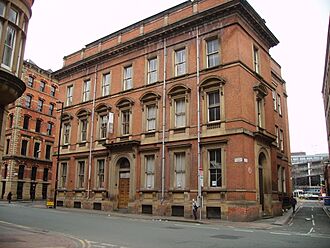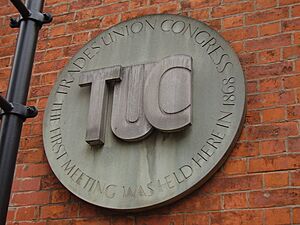Mechanics' Institute, Manchester facts for kids
Quick facts for kids Mechanics' Institute |
|
|---|---|

Mechanics' Institute, Princess Street, Manchester
|
|
| General information | |
| Architectural style | Italian palazzo style |
| Address | 103 Princess Street, Manchester, England |
| Design and construction | |
| Architect | J. E. Gregan |
| Designations | |
|
Listed Building – Grade II*
|
|
| Official name: 103, Princess Street | |
| Designated: | 10 May 1972 |
| Reference #: | 1247391 |
The Mechanics' Institute is a very important building in Manchester, England. It is located at 103 Princess Street. This building is famous because three major British groups were started here. These are the Trades Union Congress (TUC), the Co-operative Insurance Society (CIS), and the University of Manchester Institute of Science and Technology (UMIST).
In the 1960s, a business college used the building. Since 1972, it has been a Grade II* listed building. This means it is a very special historic building.
Contents
History of the Institute
How it Started
The Mechanics' Institute was created in Manchester on April 7, 1824. It was one of many similar institutes across the country. Its main goal was to help working men learn about science. They could study part-time to improve their skills.
The founders wanted to help workers understand the science behind their jobs. This would help them become better at their work. It would also help them invent new things. The institute did not teach specific trades. Instead, it taught the scientific ideas that all trades use.
Many important people helped start the institute. These included William Fairbairn and John Dalton. Benjamin Heywood was a key founder and leader. Many founders wanted to improve Manchester's business and technology. They also wanted to help working people learn and grow.
In 1825, the first building made just for a mechanics' institute was built in Cooper Street. This building was later taken down in the 1970s.
Growing and Changing
Over time, the institute focused on more than just science. It also became a place for social activities. The founders realized that workers were often too tired to study after long workdays. So, they made changes to help more people.
Around 1830, they started teaching more basic subjects. They also set up reading groups in nearby areas. These groups used books from the institute's library. The institute also encouraged sports and social events. They added a room for reading newspapers. Lectures became less focused only on science. The library also added more general books. Concerts, exhibitions, and trips became popular.
The institute also started offering classes for women and children. However, they did not allow classes on history. This was because they worried it might lead to political discussions.
In 1837, this institute organized the first big city exhibition. This led to many similar exhibitions in other English cities. These shows helped people learn about new ideas and inventions.
Moving to a New Home
The institute moved to its current building in 1855. John Edgar Gregan designed the building. It is in the Italian palazzo style. This means it looks like a grand Italian palace. The building has three tall floors, a basement, and an attic. It is made of brick with stone decorations. It was a very grand building for its time.
A very important event happened here in 1868. The first meeting of the Trades Union Congress took place in this building. This group helps workers and their unions.
Later, in 1882, a technical school was started here. It was called the Technical School and Mechanics' Institution. This school eventually grew into what is now known as UMIST.
Today
Today, the Mechanics' Institute is used as a center for conferences and meetings. It continues to be an important part of Manchester's history.
Notable People Who Studied Here
Many famous people were once students at the Mechanics' Institute.
- Mary Louisa Armitt: She founded the Armitt Library.
- Robert Whitehead: He was an engineer who developed the first self-propelled torpedo.
- Ellen Wilkinson: She was a Labour Party Member of Parliament (MP). She worked hard for social justice.


